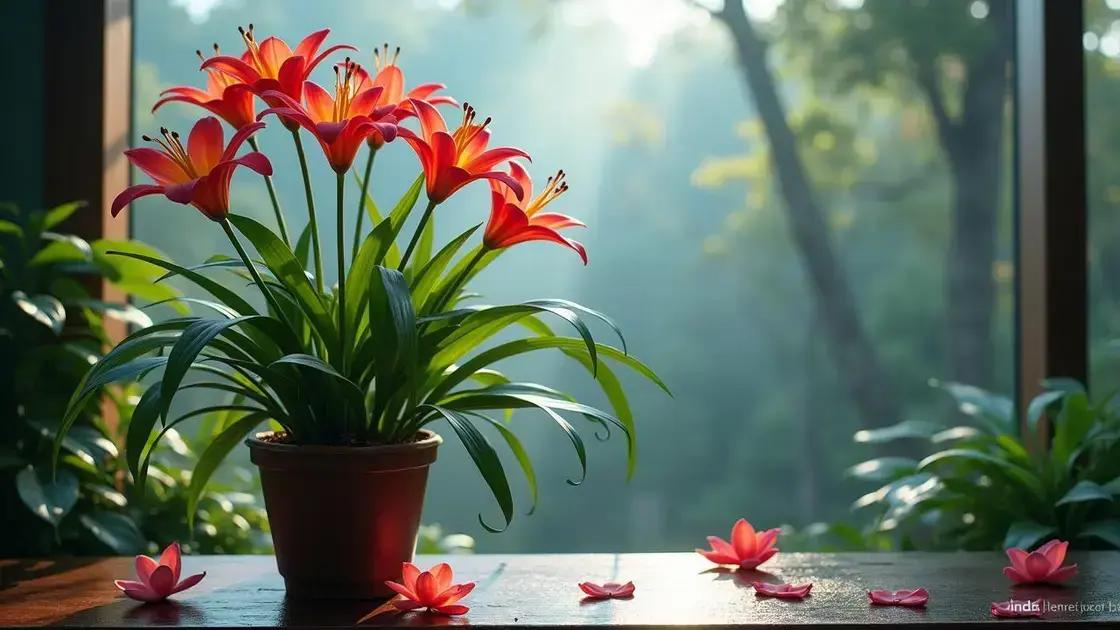How to Care for a Potted Lily Plant: 5 Essential Tips You Must Know
How to care for a potted lily plant can be a delightful journey for any indoor gardener. These beautiful flowers not only enhance your space but also require specific care to thrive. By understanding their unique needs, you can ensure your lilies bloom beautifully while brightening up your home. Let’s explore the essential ways to nurture these magnificent plants.
Table of Contents
ToggleWatering guidelines for potted lily plants
How to care for a potted lily plant involves understanding its unique watering needs. Proper watering is crucial for maintaining healthy and vibrant lily plants. Here are some essential guidelines to ensure your potted lilies thrive.
Understanding watering frequency
Watering requirements for potted lilies can vary based on several factors including the season, pot size, and your indoor climate. Generally, it’s important to follow these pointers:
- Check the soil moisture: Before watering, always check the top inch of soil. If it feels dry, it’s time to water.
- Watering schedule: During growing seasons, aim to water your lilies once a week. In winter, you can reduce this to every 10-14 days.
Preferred watering methods
There are multiple ways to water your potted lilys effectively:
- Bottom watering: Place the pot in a basin of water, allowing the roots to soak up moisture from below. This prevents overwatering and ensures even distribution.
- Top watering: Water from above using a watering can, ensuring you apply water evenly around the base of the plant.
Signs of overwatering and underwatering
Monitoring your lily plants is important to prevent watering issues:
| Condition | Symptoms |
|---|---|
| Overwatering | Yellowing leaves, root rot, and wilting despite moist soil. |
| Underwatering | Crispy foliage, drooping leaves, and dry soil. |
By carefully monitoring your watering practices, you will promote robust growth and beautiful blooms in your potted lilies. For more insights on indoor gardening care, consider exploring indoor gardening techniques.
Light requirements for thriving indoor lilies

Light requirements for thriving indoor lilies are essential for their growth and blooming success. Providing the right amount of light will keep your potted lilies healthy and promote vibrant flowers.
Optimal light conditions
Potted lilies thrive in bright, indirect sunlight. Here are the key factors to consider:
- Location: Place your lilies near a window that receives ample light without direct sun exposure, as this can scorch the leaves.
- Light duration: Aim for 12 to 16 hours of bright light daily to mimic their natural environment.
Types of light sources
Choosing the right light source is critical for indoor lilies:
- Natural sunlight: Direct sunlight in the morning or late afternoon can benefit your lilies without damaging them.
- Artificial lighting: Consider using grow lights if natural light is insufficient. LED grow lights offer energy-efficient alternatives.
Signs of improper lighting
It’s important to monitor your plant for signs of inadequate light:
| Condition | Symptoms |
|---|---|
| Too much light | Scorched leaves, fading colors, and wilting blooms. |
| Not enough light | Leggy growth, small flowers, and yellowing leaves. |
By understanding and addressing the light requirements for thriving indoor lilies, you can create an environment that fosters health and beauty. For more tips on indoor lily care, consider exploring indoor gardening techniques.
Fertilizing tips for lush lily plant growth
Fertilizing tips for lush lily plant growth are essential to maintaining vibrant and healthy potted lilies. Providing the right nutrients will enhance their blooming potential and overall health.
Understanding fertilization needs
Both indoor and outdoor lilies require specific nutrient ratios for optimal growth. Here are the key points:
- N-P-K ratio: Look for fertilizers with a balanced N-P-K ratio, typically 10-10-10 or 20-20-20, which supports balanced growth.
- Organic vs. synthetic: Choose between organic options (like compost or fish emulsion) or synthetic fertilizers depending on your gardening style.
Best fertilization practices
Implementing effective fertilization practices will ensure your lilies thrive:
- Frequency: Fertilize every 4-6 weeks during the growing season (spring and summer) and reduce during fall and winter.
- Application method: For granular fertilizers, sprinkle on the soil surface and water well. Liquid fertilizers can be diluted and applied directly to the soil.
Signs of nutrient deficiency
Regularly check your lily plants for any signs of nutrient deficiency:
| Nutrient Deficiency | Symptoms |
|---|---|
| Nitrogen | Pale green leaves, stunted growth. |
| Phosphorus | Purple-tinged leaves or stunted flowers. |
| Potassium | Yellow leaf margins and weak stems. |
By following these fertilizing tips, you can ensure lush growth and beautiful blooms in your lily plants. For more expert advice on caring for indoor plants, consider exploring indoor gardening techniques.
In conclusion
Caring for a potted lily plant involves understanding their specific needs for watering, light, and fertilization. By following the essential tips outlined in this article, you can create a thriving environment for your lilies, allowing them to bloom beautifully and flourish indoors. Remember to monitor your plants regularly and adjust your care routine as needed. For more insights and tips on enhancing your indoor garden, continue exploring reliable gardening resources.

